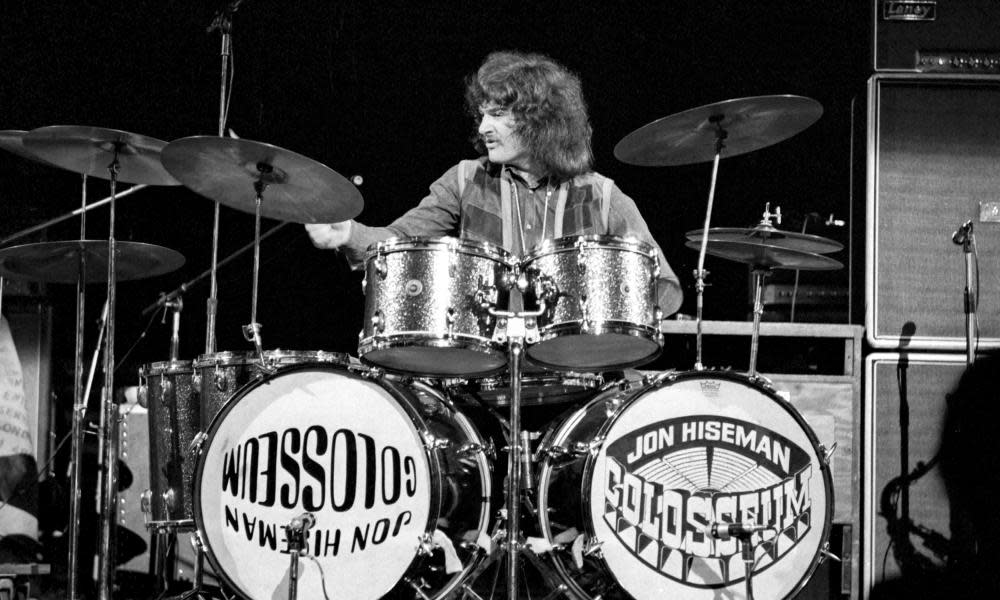Jon Hiseman obituary

Unquestionably the musical genre of jazz-rock would have happened without Jon Hiseman, who has died aged 73 after suffering from a brain tumour, but he was among the first to successfully transfer jazz improvisation to rock, and to really explore its possibilities.
His band Colosseum, often billed as Jon Hiseman’s Colosseum, had UK Top 20 albums with Those Who Are About to Die Salute You and Valentyne Suite, both in 1969. An energetic man involved in multiple projects, Hiseman was a supreme organiser as well as an open-minded bandleader.
Colosseum’s first appearance was at a disco in Scarborough in 1968. The band consisted of Hiseman, the saxophonist Dick Heckstall-Smith, former schoolfriends Tony Reeves and Dave Greenslade and, on guitar and vocals, James Litherland. Being a rock band that improvised, every show was different; the ever-changing Beware the Ides of March, for instance, began with Heckstall-Smith playing A Whiter Shade of Pale, but then, it could go anywhere.
In 1969 Litherland was replaced by Dave “Clem” Clempson, and Valentyne Suite was the band’s first album under the Vertigo imprint, the title track again showing their infatuation with A Whiter Shade of Pale. Their third UK album (there was a US-only release, Grass is Greener, drawn mainly from previous albums), Daughter of Time (1970), included Chris Farlowe on vocals. An excellent legacy of their performances is Colosseum Live (1971), a double album with six extended tracks.
John (it was Melody Maker that referred to him in 1964 as “Jon”, and he saw no reason to change it) was born in Woolwich, south-east London, to Lily (nee Spratt), who worked in the music library at the Bank of England, and Philip Hiseman, a senior lecturer in printing at Camberwell School of Arts and Crafts. Lily played the flute and piano and Philip’s family included music hall entertainers and dance band musicians.
Hiseman studied the violin and piano at Addey and Stanhope grammar school in nearby New Cross, but found that his true interest lay in the drums. He played in a school trio with Reeves on double bass and Greenslade on piano. Later he appeared in the wittily named Wes Minster Five and was a founder member of Neil Ardley and the New Jazz Orchestra.
In 1966 he played on a single, Devil’s Grip, by the Crazy World of Arthur Brown, and then accepted an offer to replace Ginger Baker as drummer in the Graham Bond Organisation, a move that allowed him to quit his day job as a marketing management trainee at Unilever. Bond used the blues as a basis for improvisation, but because he was often under the influence of heroin and alcohol while performing, the improvisation could get out of hand and the other band members would leave him on stage to fend for himself.
Frustrated, Hiseman approached Reeves and Greenslade with the idea of forming a new group with “no drug addicts, no time wasters and no passengers”. That project was briefly put on hold when John Mayall, who had seen a shambolic set by Bond and had been impressed at how Hiseman and Heckstall-Smith had managed nevertheless to follow him, invited both to join his band, the Bluesbreakers, with whom they appeared on the album Bare Wires (1968).
However, when Hiseman went on holiday to Rome with his wife, the jazz saxophonist and composer Barbara Thompson, whom he had married in 1967, he saw the Colosseum. He realised it was the perfect name for a rock band and his new project took shape.
After Colosseum split in 1971, Hiseman set up a more rock-based band, Tempest, influenced by Deep Purple and even essaying a heavy metal treatment of the Beatles’ Paperback Writer on their second album, Living in Fear (1974). The personnel on the first album, Tempest (1973), included Allan Holdsworth, Mark Clarke and Paul Williams, with Ollie Halsall later replacing Williams.
In 1975 Hiseman met the guitarist Gary Moore when they were recording a rock version of Peter and the Wolf, and for two years they toured and recorded as Colosseum II. In 1978 Andrew Lloyd Webber employed the group to record Variations, a No 2 album that included the theme tune for the ITV arts programme The South Bank Show, with his brother, the cellist Julian Lloyd Webber. Julian remembered: “Not many drummers would be able to pick up spontaneous nuances from a concert cellist but John could and did.”
Hiseman also became part of the United Jazz + Rock Ensemble, which featured some noted German musicians. Much to his amusement, an album of his drum solos with that band, titled About Time Too!, was released in 1991.
From 1982 Hiseman had his own home studio, where he recorded television and film music with his wife and played on her albums. They wrote and performed the music for several episodes of the ITV crime series A Touch Of Frost, and Hiseman also formed his own record label, TM, and ran a company that hired out recording equipment.
In 1994 Colosseum reformed with the 1971 lineup, touring regularly and making two albums, Bread and Circuses (1997) and Tomorrow’s Blues (2003). When Heckstall-Smith died in 2004, Thompson stepped in. Colosseum played their final date at the O2 Shepherd’s Bush in London in 2015, with Hiseman and Thompson’s daughter, Anna (who performs as Ana Gracey), singing with them.
Hiseman, Clempson and Clarke then came together to form a band called JCM and released Heroes (2017), a tribute to musical friends who had died.
Hiseman is survived by Barbara, their children, Marcus and Anna, and four grandchildren.
• Jon Hiseman (Philip John Albert Hiseman), drummer, born 21 June 1944; died 12 June 2018

 Yahoo News
Yahoo News 